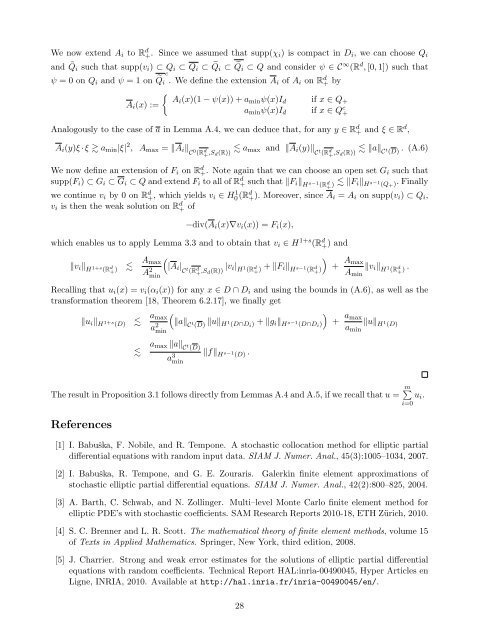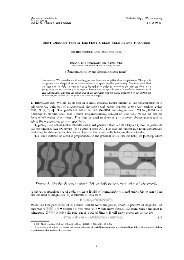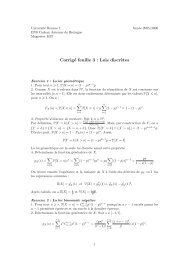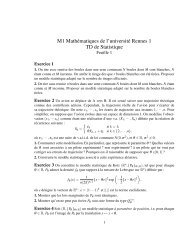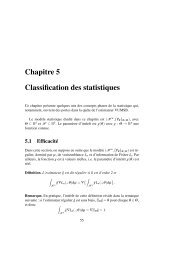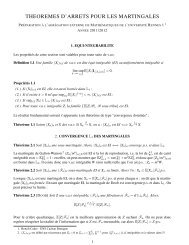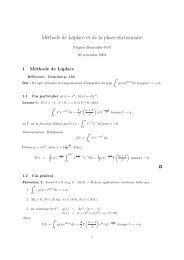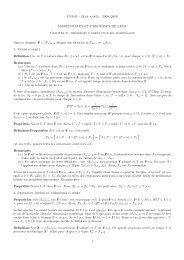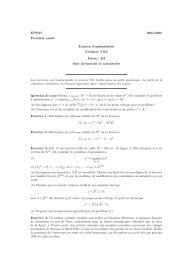Bath Institute For Complex Systems - ENS de Cachan - Antenne de ...
Bath Institute For Complex Systems - ENS de Cachan - Antenne de ...
Bath Institute For Complex Systems - ENS de Cachan - Antenne de ...
You also want an ePaper? Increase the reach of your titles
YUMPU automatically turns print PDFs into web optimized ePapers that Google loves.
We now extend A i to R d +. Since we assumed that supp(χ i ) is compact in D i , we can choose Q iand ˜Q i such that supp(v i ) ⊂ Q i ⊂ Q i ⊂ ˜Q i ⊂ ˜Q i ⊂ Q and consi<strong>de</strong>r ψ ∈ C ∞ (R d , [0, 1]) such thatψ = 0 on Q i and ψ = 1 on ˜Qci . We <strong>de</strong>fine the extension Ai of A i on R d + by{Ai (x)(1 − ψ(x)) + aA i (x) :=min ψ(x)I d if x ∈ Q +a min ψ(x)I d if x ∈ Q c +Analogously to the case of a in Lemma A.4, we can <strong>de</strong>duce that, for any y ∈ R d + and ξ ∈ R d ,A i (y)ξ ·ξ a min |ξ| 2 , A max = ‖A i ‖ C 0 (R d + ,S d(R)) a maxand ‖A i (y)‖ C t (R d + ,S d(R)) ‖a‖ C t (D) . (A.6)We now <strong>de</strong>fine an extension of F i on R d +. Note again that we can choose an open set G i such thatsupp(F i ) ⊂ G i ⊂ G i ⊂ Q and extend F i to all of R d + such that ‖F i ‖ H s−1 (R d + ) ‖F i‖ H s−1 (Q + ). Finallywe continue v i by 0 on R d +, which yields v i ∈ H 1 0 (Rd +). Moreover, since A i = A i on supp(v i ) ⊂ Q i ,v i is then the weak solution on R d + of−div(A i (x)∇v i (x)) = F i (x),which enables us to apply Lemma 3.3 and to obtain that v i ∈ H 1+s (R d +) and‖v i ‖ H 1+s (R d + ) A )max(|AA 2 i | C t (R d +min,S d(R)) |v i| H 1 (R d + ) + ‖F i‖ H s−1 (R d + )+ A maxA min‖v i ‖ H 1 (R d + ) .Recalling that u i (x) = v i (α i (x)) for any x ∈ D ∩ D i and using the bounds in (A.6), as well as thetransformation theorem [18, Theorem 6.2.17], we finally get‖u i ‖ H 1+s (D) a ()maxa 2 ‖a‖ C t (D) ‖u‖ H 1 (D∩D i ) + ‖g i ‖ H s−1 (D∩D i ) + a max‖u‖mina H 1 (D)mina max ‖a‖ C t (D)‖f‖ H s−1 (D) .a 3 min∑The result in Proposition 3.1 follows directly from Lemmas A.4 and A.5, if we recall that u = m u i .References[1] I. Babuška, F. Nobile, and R. Tempone. A stochastic collocation method for elliptic partialdifferential equations with random input data. SIAM J. Numer. Anal., 45(3):1005–1034, 2007.[2] I. Babuška, R. Tempone, and G. E. Zouraris. Galerkin finite element approximations ofstochastic elliptic partial differential equations. SIAM J. Numer. Anal., 42(2):800–825, 2004.[3] A. Barth, C. Schwab, and N. Zollinger. Multi–level Monte Carlo finite element method forelliptic PDE’s with stochastic coefficients. SAM Research Reports 2010-18, ETH Zürich, 2010.[4] S. C. Brenner and L. R. Scott. The mathematical theory of finite element methods, volume 15of Texts in Applied Mathematics. Springer, New York, third edition, 2008.[5] J. Charrier. Strong and weak error estimates for the solutions of elliptic partial differentialequations with random coefficients. Technical Report HAL:inria-00490045, Hyper Articles enLigne, INRIA, 2010. Available at http://hal.inria.fr/inria-00490045/en/.i=028


